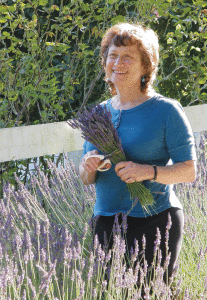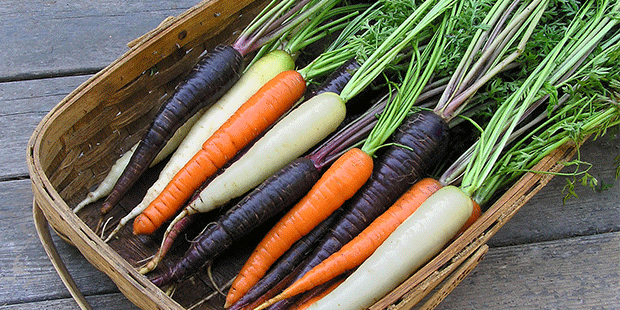The seed packets from Renee’s Garden—marked with their characteristic watercolor illustrations and descriptive, owner-tested growing instructions—can be found in independent nurseries and garden centers across the country. But it all began here, in the mid-’80s, on Renee Shepherd’s sandy-soiled Felton property.
“A thousand years ago, in the mid-’80s, this used to be just a big field, and we used to play soccer here on the weekends,” says Shepherd, looking out over the sunny expanse of her lower trial garden, where a dozen 60-foot-long raised beds await their spring plantings. “At that point, back in the mists of time, no one really knew how to play soccer very well, so we invited as many Europeans as we could.”
It was a Dutch friend, who had come to the U.S. to sell seeds to lettuce farmers, who first slipped Renee some Dutch lettuce seeds during one of their ritual after-soccer potlucks. “He said ‘why don’t you try some good-tasting varieties? In Europe we shop often and we breed for flavor, and this is all junk.’ Because Dutch people are very blunt,” explains Shepherd with a chuckle. “That was much more true in the ’80s. It’s certainly not true now—we have some of the best produce in the world.”
 She liked his Dutch lettuce, and his French tomatoes, which gave her the idea to start a mail-order catalogue called Shepherd’s Garden Seeds. In 1998, it evolved into Renee’s Garden, also available online. With a love of cooking and eating from the garden at the center of all of it, Shepherd has also written three cookbooks.
She liked his Dutch lettuce, and his French tomatoes, which gave her the idea to start a mail-order catalogue called Shepherd’s Garden Seeds. In 1998, it evolved into Renee’s Garden, also available online. With a love of cooking and eating from the garden at the center of all of it, Shepherd has also written three cookbooks.
Selling some 300 varieties of heirloom and gourmet vegetable, flower and herb seeds—and introducing around 15 new varieties each year—Shepherd and her helpers “trial” absolutely everything that they sell on her property, then again in her gardens in Vermont. What she’s looking for are the best-tasting, most productive and easiest-to-grow varieties.
On the sunny March afternoon that I visit, many of her raised garden beds are brimming with cover crops—or “green manure,” as she calls it—a mixture of ryegrass, vetch, clover and fava beans, which offer a healthy boost of organic material and vitality to the beds.
“Using a cover crop has increased our productivity by 30 percent,” says Shepherd. In Santa Cruz, cover crops, which also help retain nutrients that would otherwise be leached from the soil during winter rains, can be planted as late as November or even December, she says. That’s because we live in a gardening mecca: the growing season here is longer than in most places, and for some crops, it never actually ends.
“Right now, when I go to the supermarket, I see people who say ‘Oh, I can’t even look at you ’cause I didn’t get my garden in yet,’” she says. “But it’s actually not time yet. In Santa Cruz, you can plant all the way to July. There’s no rush. A lot of people think that if they don’t get their garden in by April or May then they’ve lost the opportunity, and it becomes a headache and a burden. But if you want cucumbers, you can plant them all the way through the end of June. From seed.” Though, she adds, the foggier areas of Santa Cruz require more time, and also the know-how of what to grow.
As Shepherd walked me through her trial gardens, I peppered her with questions for the beginning gardener.
Speaking of the foggier places in the county, I live in Aptos. What should I be growing?
What you need to do is have friends who live here to give you tomatoes, and you can give them broccoli. In the foggier parts, you can grow really great salads, and greens, and root crops, and all the cold crops for a lot longer. You can grow all kinds of fast crops like bok choy and all of those Asian crops, and mild mustards, parsley and cilantro. So other people can grow all those really hot-weather crops, but they can’t have cilantro. It’s a trade-off.
Why grow vegetables from seed?
The benefits of growing from seeds is huge diversity of varieties. So, for example, I probably have access to 300 kinds of lettuce, and 1,200 kinds of tomatoes. If you want to grow real Portuguese kale, or real Italian basil—or, in other words, the best-tasting, most diverse, healthiest, most colorful vegetables and flowers—[grow from seed], because wholesalers who grow six packs, they’re doing a good job, but they don’t pay as much attention to diversity.
Also, it’s lot cheaper. I’m going to give you 500 to 1,000 lettuce seeds in a packet, and you can plant several times. And third, it’s way more fun. You know, you plant a seed, it comes up, which is always like a miracle, and then plants grow to maturity and you see the whole cycle. And you have much longer crops. Did I give you enough reasons yet?
What are some of the trends you’re seeing now?
Colored vegetables are really big, because they have more nutrition. Every different color has a different antioxidant, and purple was big—for example, purple sweet potatoes—because that purple antioxidant is one of the strongest in wiping out free radicals. So the more color, the more nutrition.
The other thing that is now very popular is root vegetables. So, for example, in the last few years we’ve introduced parsnips, we’ve introduced celeriac. If you had told me five years ago that I was going to be selling rutabagas, I would have laughed at you. But chefs are really into root vegetables, because everybody is into roasting vegetables. So if you have celeriac and rutabagas and carrots and turnips and potatoes, you can throw them all with olive oil and roast them and they’re delicious.
And, pollinator-friendly varieties, because everyone’s concerned about the bees. I sell a huge amount of old-fashioned, heirloom, cottage garden flowers. And now I add “pollinator friendly” to everything. But six years ago, people didn’t want flowers that attracted bees. So things are very trendy in our industry, just like anything else.
How about herbs?
Most popular herb is cilantro. It took over from basil a few years ago. We sell more cilantro. And I carry regular, slow-bolting cilantro, which means it stays in leafy stage longer. And I also sell a Vietnamese cilantro; it’s from Bac Lao in Vietnam, and it has a more frilly leaf. It has a little lemon flavor, it’s a more delicate flavor. And basil is still very important. We carry about eight kinds.
What is your best seller?
A mix of white, orange and purple carrots we call “Circus Circus,” because it’s bright circus colors. Two or three hundred years ago, all carrots were either yellow, white or purple. And in India, they only eat purple ones. So orange is a fairly modern adaptation.
What are some tips you give people locally who want to grow from seed?
A lot of people have got the idea that to start from seed you have to start indoors. In Santa Cruz, the only things you must start indoors are tomatoes, eggplants and peppers. Because those three are tropical crops that need a long, hot season, so you start them indoors to give them a jump on the season. The other thing about planting from seed is—see, these are all about an inch apart, and the important thing we’re going to do to these [carrots] is we’re going to thin them again. We’re actually going to pull out every other one, so that the remaining ones have a chance to size up. And if I was going to say the other main problem that people have growing from seed, it’s because they don’t thin them out.
Yeah, it seems like such a shame to pull seedlings out, but you really need to follow the thinning instructions on the packet, huh?
Well, the way to frame it in your mind is that if you don’t thin things to the proper spacing, you are torturing them. Two zucchini plants planted far enough apart will produce a thousand times as many zucchini as five or six zucchini all tangled together, because they’ll just want to fruit and die. Another classic example is, basil likes to be six, seven inches apart, and then produce lots of leaves. If you plant them close together, they get real crowded. That’s important, because basil has a high germination rate, and it will all come up, and you’ll have 100 seedlings—and if you let them all grow together you’ll get something, but it will be all tangled plants growing straight up. But if you dig them up, take them carefully apart, and plant them six inches apart, you’ll have a much longer season.
When should we be planting our basil?
In Santa Cruz, it’s generally good to plant it as soon as the nights are in the 50s, and then plant another crop at the end of June or early July—and if you grow a second crop, then you’ll have basil when all of the tomatoes are ripe.
What would you recommend for people who have limited time and limited space?
Lately I’ve been really interested in cut-and-come-again greens. Things that you can grow baby-leaf, like lettuce, where you can grow a lot in a small space. So instead of one or two chard plants, you plant it by the cut-and-come-again method, which means you plant it very thickly, like grass. When it gets about four-six inches tall, you just cut as much as you want for dinner. And you can stir fry it or braise it, and as you can see, that’s enough to feed a lot of people. And in the cool season of the year, like now, this [chard] will come back three times, at least.
If I was doing this for my home garden, I would be growing thecut-and-come again kale and chard, I’d be planting lettuce, carrots, beets. I love Italian parsley, chives—I would grow a salad garden if I had a limited space. Because in Santa Cruz you can grow a salad garden almost year-round, and you can plant it several times.
Visit reneesgarden.com for in-depth growing instructions, seeds and recipes. Also find a wide range of tutorial videos on the Renee’s Garden YouTube channel.

